JungSon JA88D-09
Purchased
Dec. 2009
Copyright
2010 © Troels Gravesen
I needed a decent
amp for my workshop in replacement of
the Rotel RB981, which is not a particularly bad
amp, but it has its shortcomings. I build a lot
of different speakers and people bring in a lot
of speakers with the all too common 85-90 dB
sensitivity, speakers my SET valve amps simply
can't play very loud. If only I could have some
of the midrange quality of my SET amps - and
60-100 watts, I'd be more than happy.
I've recently listened to a few newer class A
amps like the Clearaudio 50 wpc power amp and I
certainly liked what I heard. Now, 50-100 watts
class A solid state amps are not the most common
thing on the shelves of hifi stores and for some
time I was seriously considering a 100 wpc PP
valve amp of some kind, but valve amps usually
requires a lot of tweaking to perform their best
and for my workshop amp I felt more inclined to a
plug'n-play solution and it wouldn't hurt with
some solid watts that could at least try to push
some life into dull bass drivers.
After a lot of discussions
with one of my friends, I decided to try out the
JungSon JA88D amplifier, actually an integrated
amp, and now in an "-09" version with a
few improvements compared to former model
introduced 2003. I like the fact that this amps
has been marketed for a number of years and that
a new model really only has a few changes based
on the comments from reviews. It seems the basic
design has something right and my salute to
JungSon for not making changes for the sake
change and pure marketing.
The criticism on the -03 version was basically
minor noise and hum and a slightly problematic
treble performance when run at high output. It
appears all these problems are gone. The volume
control circuitry is probably state of the art,
but the remote and the speed with which the
volume control works is definitely not up to
B&O standard. However, I use the Jungson with
my WOT line stage and the JungSon volume setting
is on steady "55", thus no problem.
The JA88D-09 has excellent sensitivity and
there's really no need for a line stage, but the
thing is that it just sounds a tiny bit better
with my WOT line stage. Maybe a little second
harmonic distortion really balances the JungSon's
dominant 3rd harmonic distortion making it a
little less "clean", because run alone,
this amp is a clean performer with an unusual
transparent midrange, a solid bass and - to my
ears - clean treble. Maybe they have improved on
treble performance as well.
This amp is HUGE!
Weighing close to 30 kgs and running 2 x 80 watts
class A - at least from specs. I had expected a top panel
suitable for frying eggs. This is definitely not
the case. Compared to my 6AS7 valves (Audio
Mirror) consuming some 300 watts, this Jungson is
cool. Apparently the 1.8 square meters of copper
cooling panels are doing a great job of getting
rid of heat.
The amp draws an idle current of 0.75 amperes,
making ~173 watts, although my power meter tells
80-90 watts due to the voltage/current phase
shift. The MC and line stage will consume very
little power compared to the output stage. So, what's the real
class A rating of this amp? Go to
Hedo/Duro page
to get an idea.
With a sound quality like
this for ~700 USD (Cattylink, Hong
Kong), even the thought of making some diy solid
state seems pointless. We couldn't even buy the
components for this price. In short this amp is
awesome and must be a serious competitor to amps
many times its price.
(In total I paid 1077 USD incl. shipping + an
additional DHL fee of 90 USD. For DK customers
there may be an additional 25% VAT of the 215 USD
value stated on shipping papers).
Having mentioned my
supplier above has caused some response
from people very unsatisfied from buying gear
from Cattylink. To my knowledge only Cattylink
and Ornec sell Jungson equipment from Hong Kong.
Whenever I buy components from Hong Kong or China
I take my chances and I'm willing to loose my
money. I never expect any return of goods, any
warranty or whatever, so don't take the above as
a recommendation of a reliable supplier. I can't
tell. Use google to find out about your supplier
and make up your mind if you're willing to risk
your money. I searched Cattylink and found good
and bad. If you're wearing belt and suspenders, I
suggest buying from a local retailer.
Read reviews:
Australian
Hi Fi Magazine September 2006 Review on JA-88D
World Hi
Fi Review on JA-88D
Feb. 2010, I had this mail from
Finland:
Hello, I have noticed that you have been excited
about your amplifier, congratulations , good
choice! Just wanted to tell more about the
history behind that amplifier and the other
JungSon amplifiers...In the 90`s there was a
Swedish high-end brand called Forsell. The man
behind the brand was Peter Forsell, Swedish
doctor/dentist who develop lot of stuff in the
medical purposes. He was also interested about
high-end and started to build very good
equipments based on his innovations, example
Forsell air reference turntable wich basically is
kept off the ground with compressed air...Nice
idea! I dont know what exactly happened but I
think he just get bored developing more in the
audio world, however, the circuitry and biasing
technology were adopted then in a few
brands, at least there is Adyton and Oasis
audio. The brand Oasis audio were sold in the USA
sometime ago and the look of those is exactly
like...you can guess, same as JungSon has. I
think Peter Forsell sold licenses to build
amplifiers based on his circuitry for Norwegian
Adyton and to the Oasis audio who then started to
manufacture amplifiers in the China, Jungsons
factory. So, you basically have Forsell amplifier
which costed insane numbers in the 90`s! There
propably is mistakes here or there so don't get
all my info too serious but just wanted to share
my info :) p.s just ordered 4pcs of Eminence
10" from the Thomann...Regards, Niko.
|
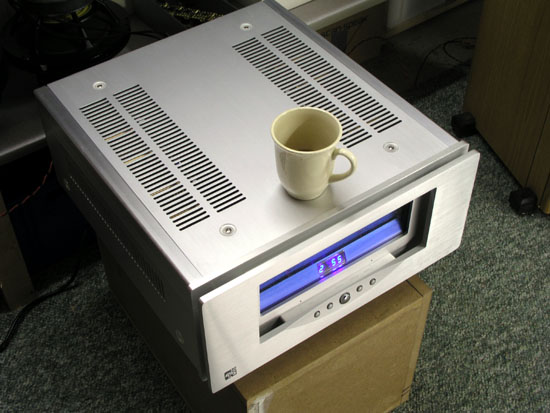 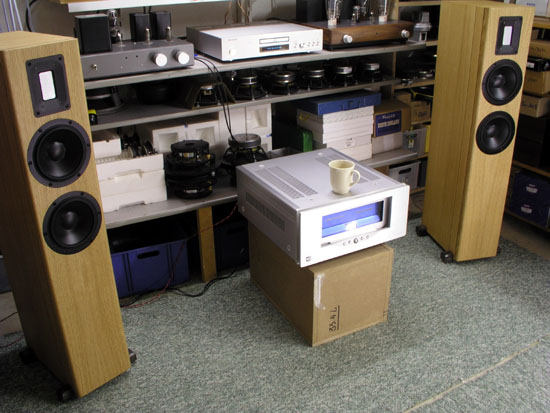
Left: Don't count on keeping your coffee warm on this
amp! Right: The JungSon running my ATR-25 speakers in the
workshop.
Fortunately the amp fits well on the lower shelf behind.
What's inside?
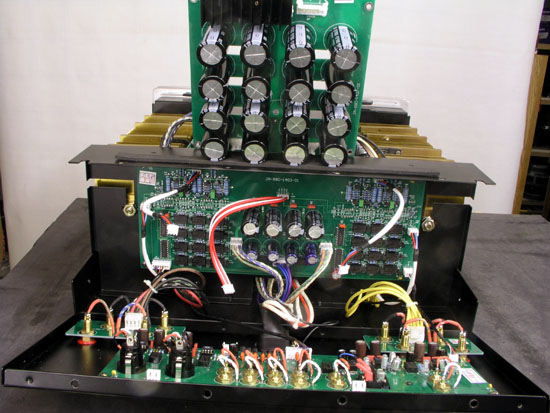 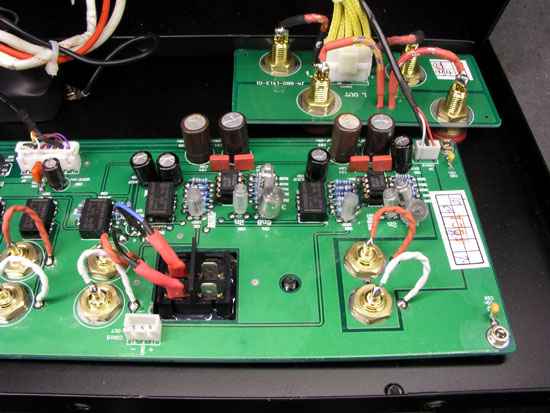
Left: Rear panel released and we have access to input
panel with switching relays, attenuator section, MM-MC
amplifier, balanced inputs and line stage.
Right: MM-MC section based on two op-amps; probably not
the very best RIAA the world has seen, but if vinyl is
not your primary source of music, it may do well.
Quite a switch for MM or MC selection!
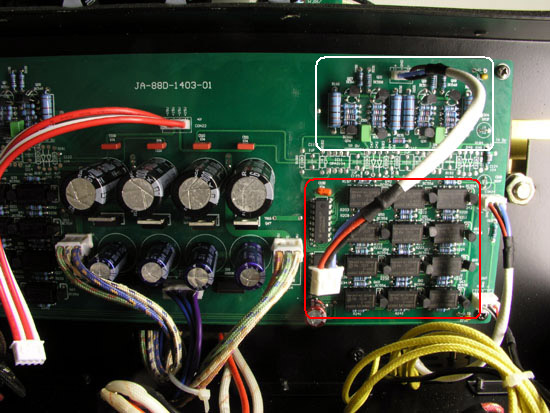 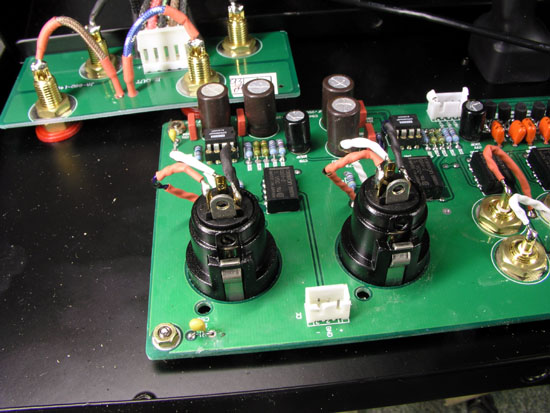
Left: Line stage encircled with white. Attenuator section
encircled with red. Right: Balanced input section.
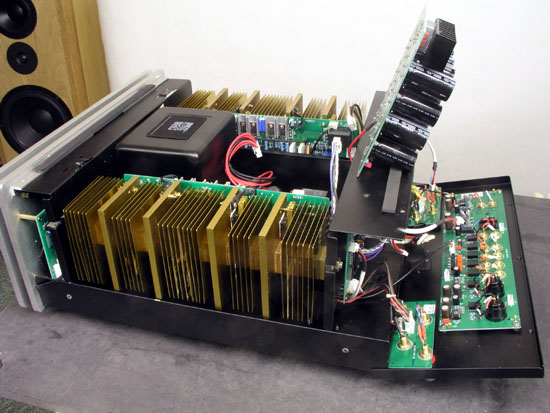 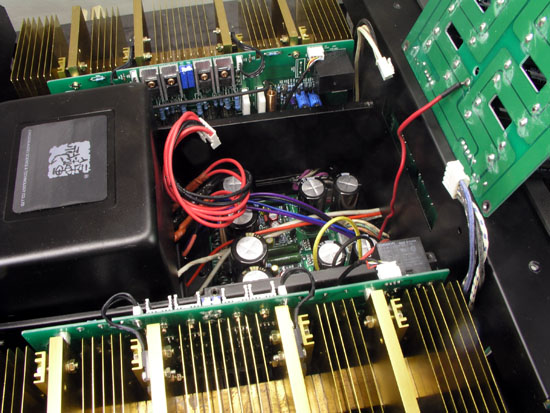
Left: Massive cooling panels and main capacitor bank
removed. Below all the electrolytics we find a regulated
power supply for the phono and line stages.
To remove the regulated PSU we have to un-solder the red
wire going to the main capacitor bank.
Regulated PSU
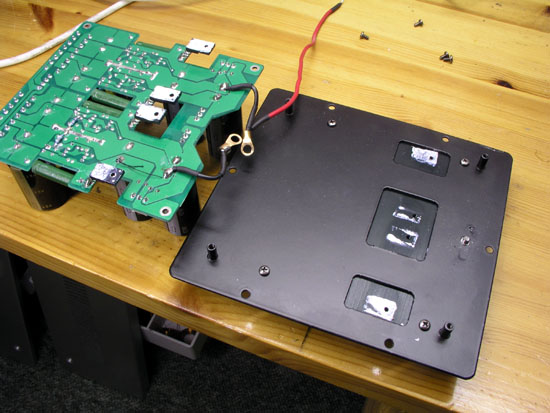 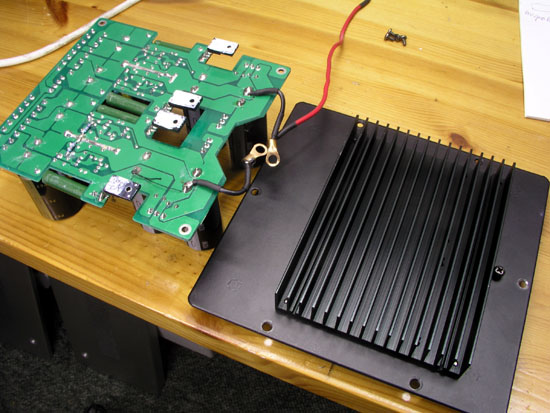
On the bottom of the amp
we find a cooling sink for four semiconductors.
It appeared these four devices weren't fastened
to the sink. Now, quality control may not be the
middle name of Chinese products but I can't tell
whether these semiconductors really need cooling,
but as heat transfer pasta had been applied to
the sink, I guess some screws were missing. I'd
been running the amp for some 50 hours before
discovering this, so the heat sink may not really
be needed, but for the benefit of the doubt I
added more pasta and attached the semiconductors
as can be seen below. The semiconductors do not
need electrical insulation. After this I
assembled the amp and had it running for 15
minutes before adding the top plate. I measured
12 and 15 mV on out-put terminals, which is
excellent. No smoke or bad smells :-)
|
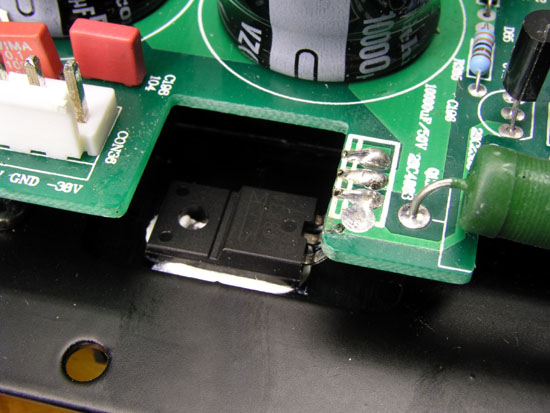 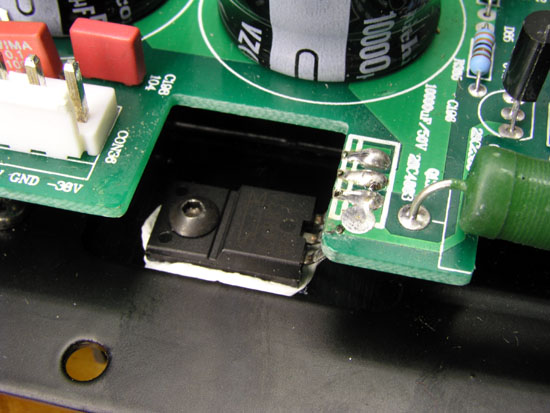
Modifying
JungSon JA88D to power amp only
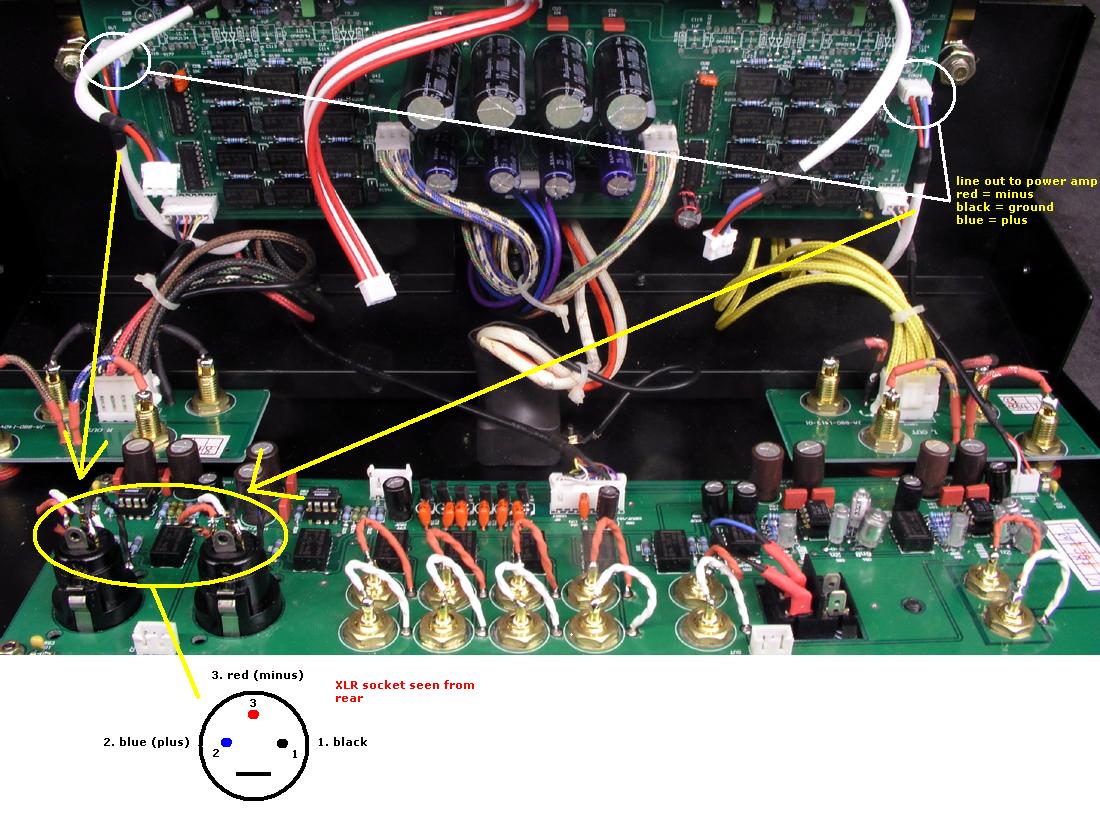
Standard XLR wiring says: pin 1 = shield
(ground), pin 2 = plus, pin 3 = minus.
Remove all cables from XLR sockets and unsolder wires
also from the circuit board.
For some reason JungSon has chosen red for
minus and blue for plus. Hmm... Extend wires from power
amp module and connect black to pin 1, blue to pin 2 and
red to pin 3. Obviously the volume control is now no
longer in action and the JungSon works as any other power
amp. You need two XLR plugs and running from standard RCA
line stage outputs, you connect plus to pin 2
and minus to pin 1 and
3 on the XLR plug.
Using the Jungson as a power amp
only, I shorted the input caps. Read the Hedo/Duro file to see how.
Also check the Hedo/Duro - the
power section of this amp -
here. Here you'll
read what this amp really deliver in class A. Don't be disappointed,
it's the sound that counts.
2012
After having my
Swedish friend analysing the Jungson schematrics it was time to
change the coupling caps between driver stage and power stage. I had
already removed the input electrolytics but had been waiting for the
silver-golds to arrive.
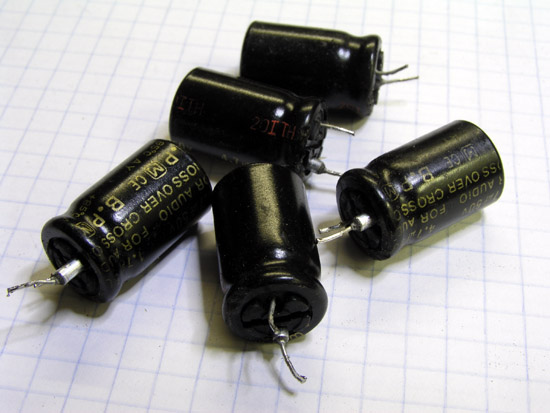
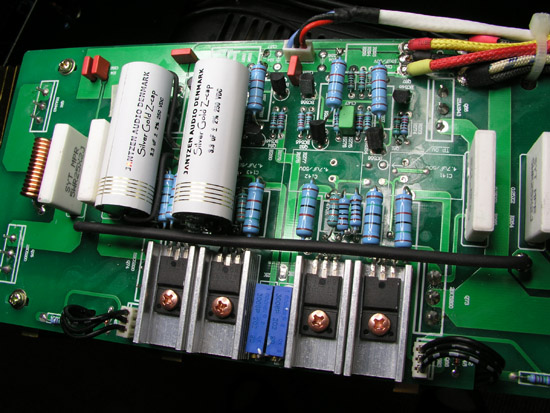
Left: Former electrolytic coupling caps. Right: Two of the new silver-golds
in place.
To make a long story short, you
haven't heard what your Jungson/Duro/Hedo is capable of before all these
electrolytic coupling caps are gone!
I have a 45 rpm Denon test LP
where the male chorus used to be so-and-so, not really unpleasant, but
male choruses are generally trouble and we may excuse our system of not
being capable of handling the extremely complex signal and think it will
never really sound good regardless of amps and speakers - until we
discover another bottleneck in the overall chain.
The flute and
generally woodwind instruments loose a bit of the shape edge in
transient passages. In short, more detail, more timbre. Listening has
become easier in the never ending pursuit of aural nirvana. Highly
recommended.
TECHNICAL:
The 3.3 uF/250V silber-golds
(prototypes) used here are without the alu tube and only 17 mm diameter
- and whatever you use, you shouldn't use caps with a diameter more than
this, because there isn't room for much more. However, 1-1.5 uF will do
and current e.g. 1.0 uF/800V is 18 mm in diameter. Current 3.3 uF/250V
from Jantzen Audio are 30.5 mm diameter and too large.
Removing the
electrolytic caps is a bit tricky as we can't get to the rear side of
the circuit board, thus gently pull the caps over and pull out the
termination of the capacitor as can be seen from photo above to the
left. When the wire is exposed add your solder iron and remove the wires
one by one. Use insulation on new cap wires to make sure not to short
any components. If you're not used to this kind of tweaking leave it to
a professional. It's not one of the easy tweaks. Take utmost care not
damaging the circuit board!
Last, but not least, only do this when operating the amplifier as a
balanced power amp from an AC coupled line stage. I did
not add input capacitors to the board as I use a transformer coupled
line stage. I don't know if the Jungson line stage is AC or DC and
please do not ask. I don't know. I'm not an expert in electronics and
can't provide further advise.
|














